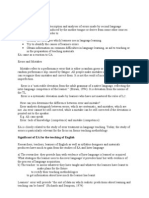Seven Theories of Sla
Seven Theories of Sla
Uploaded by
Kristel CachaCopyright:
Available Formats
Seven Theories of Sla
Seven Theories of Sla
Uploaded by
Kristel CachaOriginal Description:
Copyright
Available Formats
Share this document
Did you find this document useful?
Is this content inappropriate?
Copyright:
Available Formats
Seven Theories of Sla
Seven Theories of Sla
Uploaded by
Kristel CachaCopyright:
Available Formats
SEVEN THEORIES OF SLA
1. The Acculturation Model
Proponent: John Schumann (1978)
Central Premise: “... second language acquisition is just one aspect of acculturation and the degree to
which a learner acculturates to the target language group will control the degree to which he acquires
the second language.”(Schumann 1978:34)
Brown (1980) defines acculturation as ‘the process of becoming adapted to a new culture’.
Acculturation, and hence SLA, is determined by the degree of social & psychological distance
between the learner and the target language culture.
When social and psychological distances are great, the learner fails to progress beyond the early
stages, with the result that his language is pidginized.
Nativization model (Andersen, 1980,-81,-83)
Evaluation: The Acculturation & Nativization Models address naturalistic SLA, where the L2 learner has
contact with the target language community. What is missing from these models is an account of the
role of the interaction between situation & learner.
2. Accommodation Theory
Proponent: Giles (
Main Principles: Ingroup defines itself in relationship to the outgroup.
Key Variables: Level of motivation is a reflex of how learners see themselves in ethnic terms.
a. Identification of the individual learner with his ethnic ingroup
b. Inter-ethnic comparison
c. Perception of ethno-linguistic vitality
d. Perception of ingroup boundaries
e. Identification with other ingroup social categories
In language acquisition, learner leans towards upward divergence. In fossilization, learner leans
towards downward divergence.
Evaluation: This theory relates the acquisition of a new dialect or accent to the acquisition of a L2, as
both are seen as a reflection of the learner’s perception of himself with regard to his own social group
and the target language/dialect group. Further, this theory provides an explanation of language-learner
language variability.
3. Discourse Theory
Proponent: Evelyn Hatch (1978)
Main Principles: 1) SLA follows a 'natural' route in syntactical development;
2) Native speaker adjust their speech in order to negotiate meaning with non-native speakers;
3) The conversational strategies used to negotiate meaning, and the resulting adjusted input,
influence the rate and route of SLA in a number of ways, namely: a) the learner learns the grammar of
the L2 in the same order as the frequency order of the various features in the input, b) the learner
acquire commonly occurring formulas and then later analyses these into their component parts & c)
learner is helped to construct sentences vertically; vertical structures are the precursors of horizontal
structures;
4) Thus, the ‘natural' route is the result of learning how to hold conversations.
Evaluation: The discourse theory does not address the nature of the learner strategies responsible for
SLA.
There is no specification of the relationship between external and internal processes.
Hatch only talks of external process- those which can be observed in face-to-face interaction- not
internal processes, those that can only be inferred by observing how learners perform but of course, she
does not dismiss the cognitive side of SLA.
4. The Monitor Model
Proponent: Krashen (1981, -82)
Five Central Hypothesis:
1) Acquisition learning hypothesis;
2) Natural order hypothesis;
3) Monitor hypothesis - monitoring has an extremely limited function in language performance, even
where adult are concerned. Krashen gives three conditions for its use; a) there must be sufficient time. b)
the focus must be on form and not meaning and. c) the user must know the rule;
4) Input hypothesis- input that comprehensible to the learner will automatically be at the right level;
5) Affective filter hypothesis. It deals with how affective factors relate to SLA, and covers the ground of
the Acculturation model.
Causative variables taken into account in the Monitor Model: aptitude, role of the first language,
routines and patterns, individual differences and age.
Evaluation: Despite the comprehensiveness of the this model, it poses serious theoretical problems
regarding the validity of the acquisition-learning distinction, the operation of Monitoring, and the
explanation of variability in language-learner language.
You might also like
- Language AcquistiionDocument6 pagesLanguage AcquistiionShady AbuyusufNo ratings yet
- Error AnalysisDocument3 pagesError AnalysisMeryem Amy LeeNo ratings yet
- Contrastive Analysis (CA)Document2 pagesContrastive Analysis (CA)Amira BenredjemNo ratings yet
- DiglossiaDocument9 pagesDiglossiaWardani Dwi WNo ratings yet
- Bilingualism and DiaglossiaDocument4 pagesBilingualism and DiaglossiaRuth BerryNo ratings yet
- IsoglossDocument1 pageIsoglossNinaNo ratings yet
- Error AnalysisDocument16 pagesError AnalysisAzra GhaziNo ratings yet
- Linguistic Register and Code SwitchingDocument6 pagesLinguistic Register and Code SwitchingRea Jane B. MalcampoNo ratings yet
- 07 - Chapter 2 SLA TheoriesDocument73 pages07 - Chapter 2 SLA TheoriesPerlita VegaNo ratings yet
- Wardhaugh Chapter 4Document2 pagesWardhaugh Chapter 4Jude0% (1)
- Bilingualism Is A Worldwide PhenomenonDocument4 pagesBilingualism Is A Worldwide PhenomenonHamzaTamimiNo ratings yet
- Key Issues in SlaDocument11 pagesKey Issues in SlaHartono Hart100% (1)
- Applied LingDocument11 pagesApplied Lingحسام جدوNo ratings yet
- Intro To Sociolings 6 Final ReviewDocument65 pagesIntro To Sociolings 6 Final ReviewNel SweetieNo ratings yet
- Krashen's Input Hypothesis and English Classroom TeachingDocument4 pagesKrashen's Input Hypothesis and English Classroom TeachingNagato PainwareNo ratings yet
- Sociolinguistic AssignmentDocument11 pagesSociolinguistic AssignmentRiska Alfin Pramita100% (1)
- Communicative Language TeachingDocument8 pagesCommunicative Language TeachingBima Nusantara100% (1)
- The Audio Lingual MethodDocument39 pagesThe Audio Lingual MethodThao VuNo ratings yet
- Communicative CompetenceDocument2 pagesCommunicative CompetenceLevente Jambrik0% (1)
- 1Document9 pages1sumayya tariqNo ratings yet
- FossilizationDocument8 pagesFossilizationHaytham AL-FaqihNo ratings yet
- The Role of Media in Language StandardizationDocument14 pagesThe Role of Media in Language StandardizationMark peter100% (1)
- Introduction To SociolinguisticsDocument3 pagesIntroduction To SociolinguisticsUtshab SuhaNo ratings yet
- CHP 14 Second Language AcquisitionDocument5 pagesCHP 14 Second Language AcquisitionVivianaGosalNo ratings yet
- Subtractive and Aditive BilingualismDocument9 pagesSubtractive and Aditive BilingualismAida Araceli Lizárraga ÁvilaNo ratings yet
- Sociolinguistics - Language and SocietyDocument5 pagesSociolinguistics - Language and SocietyAna Nosić100% (1)
- Is Language Innate or LearnedDocument2 pagesIs Language Innate or LearnedAhmed altaloolNo ratings yet
- Generativism: Chomsky's Linguistic ConcernsDocument52 pagesGenerativism: Chomsky's Linguistic ConcernsSalam Neamah HakeemNo ratings yet
- Error AnalysisDocument4 pagesError Analysisrusiru_chitrasena7478No ratings yet
- Principles of Syllabus Organization 1Document18 pagesPrinciples of Syllabus Organization 1Sheryl Ann Tumacder DionicioNo ratings yet
- Bilingualism and MultilingualismDocument16 pagesBilingualism and MultilingualismMUHAMMAD SHAHIDNo ratings yet
- Discourse AnalysisDocument9 pagesDiscourse AnalysisDianeNo ratings yet
- The Contrastive Analysis HypothesisDocument1 pageThe Contrastive Analysis HypothesisDorepeNo ratings yet
- Definition and Types of Bilingualism and MultilingualismDocument4 pagesDefinition and Types of Bilingualism and MultilingualismMaya MuthalibNo ratings yet
- Summery of Cognitive AccountsDocument2 pagesSummery of Cognitive AccountsDaryantoNo ratings yet
- Chapter 13: First Language AcquisitionDocument2 pagesChapter 13: First Language AcquisitionJazz CarbajalNo ratings yet
- BASICS OF PsycholinguisticsDocument6 pagesBASICS OF Psycholinguisticshusnain.y4827No ratings yet
- SUMMARYDocument7 pagesSUMMARYLuis J. MartinezNo ratings yet
- LinguisticsDocument14 pagesLinguisticsGlennmeloveNo ratings yet
- Literature Review On Code Switching and Code MixingDocument6 pagesLiterature Review On Code Switching and Code MixingafmzfxfaalkjcjNo ratings yet
- Relation Between Language and CultureDocument2 pagesRelation Between Language and CultureAnza RajpootNo ratings yet
- Introduction..Polysemy and HomonymyDocument6 pagesIntroduction..Polysemy and HomonymyClaudia Elena NegurăNo ratings yet
- Assignment: StructuralismDocument2 pagesAssignment: StructuralismGeorgeiyRoy100% (1)
- The Role of Input in Second Language AcquisitionDocument6 pagesThe Role of Input in Second Language AcquisitionJOURNAL OF ADVANCES IN LINGUISTICS100% (1)
- 02-General Theories On Second Language Acquisition and LearningDocument16 pages02-General Theories On Second Language Acquisition and LearningJccd JccdNo ratings yet
- Sociolinguistics - Unit One 2 22222Document9 pagesSociolinguistics - Unit One 2 22222Jervàcio ChambalNo ratings yet
- University of Zawia: Post-Graduate Studies Department of EnglishDocument4 pagesUniversity of Zawia: Post-Graduate Studies Department of EnglishMarwa Alkowash0% (1)
- Pidgin and Creole LanguagesDocument3 pagesPidgin and Creole LanguagesShakira EnnNo ratings yet
- Saussure's Structural LinguisticsDocument10 pagesSaussure's Structural LinguisticsHerpert ApthercerNo ratings yet
- (Elt) The Linguistics of Contrastive AnalysisDocument22 pages(Elt) The Linguistics of Contrastive Analysislolalo123100% (2)
- Discourse Analysis Key ConceptsDocument5 pagesDiscourse Analysis Key ConceptsFrancis B. TatelNo ratings yet
- Applied LinguisticDocument23 pagesApplied LinguisticFatulous100% (1)
- History and Types of GrammarDocument6 pagesHistory and Types of GrammarJesica Dy IcoNo ratings yet
- 08 Teaching GrammarDocument23 pages08 Teaching GrammarGab GapasNo ratings yet
- Linguistic CompetenceDocument4 pagesLinguistic CompetenceSadiqueAliPeerzadaNo ratings yet
- Topic 3Document7 pagesTopic 3Ainhoa Sempere Ilazarri100% (1)
- Teacher Language Awareness: A Discursive EssayDocument19 pagesTeacher Language Awareness: A Discursive EssayEstherRachelThomas100% (1)
- Language Shift and Language MaintenanceDocument8 pagesLanguage Shift and Language MaintenanceSekarlangit Umastuti TjitrosoediroNo ratings yet
- Cultural Migrants and Optimal Language AcquisitionFrom EverandCultural Migrants and Optimal Language AcquisitionFanny Forsberg LundellNo ratings yet
- Theories of Sla ExamDocument2 pagesTheories of Sla ExamKristel CachaNo ratings yet
- The Bilingual Brain: Parlez Vous Francais? Sprechen Sie Deutsches? Hablas Español? If SoDocument4 pagesThe Bilingual Brain: Parlez Vous Francais? Sprechen Sie Deutsches? Hablas Español? If SoKristel CachaNo ratings yet
- Analyzing Your Audience NotesDocument9 pagesAnalyzing Your Audience NotesKristel CachaNo ratings yet
- Phonological ProcessesDocument1 pagePhonological ProcessesKristel CachaNo ratings yet
- Language Assessment Principles ActivityDocument2 pagesLanguage Assessment Principles ActivityKristel CachaNo ratings yet
- Allen 2007Document21 pagesAllen 2007anirban_2014No ratings yet
- The Whole School, Whole Community, Whole Child ModelDocument1 pageThe Whole School, Whole Community, Whole Child ModelDiana GarciaNo ratings yet
- Caring For A PedophileDocument1 pageCaring For A PedophileEmy Noviana SandyNo ratings yet
- Miller-1999-Journal of Counseling & DevelopmentDocument4 pagesMiller-1999-Journal of Counseling & Developmentrishi kantNo ratings yet
- Questionnaire OCAI Tool EnglishDocument13 pagesQuestionnaire OCAI Tool EnglishSatriadi GunawanNo ratings yet
- DocxDocument3 pagesDocxGerazo, Kaye Jeacinne V.No ratings yet
- Pioneers PDFDocument2 pagesPioneers PDFAdinda Hasya PutriNo ratings yet
- Sociocultural TheoryDocument31 pagesSociocultural Theoryphuong linhNo ratings yet
- Andrea Dejchai ExeterDocument1 pageAndrea Dejchai ExeterndejchaiNo ratings yet
- Torres Harding Siers Olson 2012 Development and Psychometric Evaluation of The Social Justice ScaleDocument12 pagesTorres Harding Siers Olson 2012 Development and Psychometric Evaluation of The Social Justice Scalefakhri mackrostNo ratings yet
- Good Me' or Bad Me' - The Sullivan Approach To Personality - The New York TimesDocument15 pagesGood Me' or Bad Me' - The Sullivan Approach To Personality - The New York TimesMyrrh ChaNo ratings yet
- Health Concept LaymanDocument3 pagesHealth Concept LaymanAlexis Rosco SalvatoreNo ratings yet
- Howto Win Friendsand Influence PeopleDocument6 pagesHowto Win Friendsand Influence PeopleRaja SekharNo ratings yet
- Self ConceptDocument2 pagesSelf ConceptMc Jaryl HernandezNo ratings yet
- PROF - ED - PreBoard 2014 PDFDocument18 pagesPROF - ED - PreBoard 2014 PDFElla MariscalNo ratings yet
- TP525 3 7Document39 pagesTP525 3 7Jasmin KeiberNo ratings yet
- Arw1 Midterm Exam: SECTION I: Reading ComprehensionDocument5 pagesArw1 Midterm Exam: SECTION I: Reading ComprehensionRafael Torres de la CoronaNo ratings yet
- Status and RoleDocument4 pagesStatus and Rolearman.tiwari1804No ratings yet
- Critically Evaluate The Application of Leadership Theories To A Leader in An Organisational ContextDocument8 pagesCritically Evaluate The Application of Leadership Theories To A Leader in An Organisational ContextMitika MahajanNo ratings yet
- Module 7 LeadershipDocument41 pagesModule 7 LeadershipmgllacunaNo ratings yet
- A Study On The Effects of Broken Home Towards The Learners' Behavior and Academic PerformanceDocument39 pagesA Study On The Effects of Broken Home Towards The Learners' Behavior and Academic PerformanceAesir ArchitectNo ratings yet
- The Effect of Text Color and Text Grouping On Attention and ShortDocument32 pagesThe Effect of Text Color and Text Grouping On Attention and Shortnate higgerNo ratings yet
- Demonstrating Felt LeadershipDocument6 pagesDemonstrating Felt LeadershipDEEPAK KUMAR100% (1)
- Hannah Kim Psychology 3rd Prize 2023Document13 pagesHannah Kim Psychology 3rd Prize 2023Shobha SinghNo ratings yet
- Adolescence Typically Describes The Years Between Ages 13 and 19 and Can Be Considered The Transitional Stage From Childhood To AdulthoodDocument12 pagesAdolescence Typically Describes The Years Between Ages 13 and 19 and Can Be Considered The Transitional Stage From Childhood To AdulthoodCAREN-JOY BARNIEGONo ratings yet
- PA 211 Course Plan Summer 24 ABDocument4 pagesPA 211 Course Plan Summer 24 ABSaima NandingNo ratings yet
- Part A Unit-Ii Self Management Skills: Questions and AnswersDocument2 pagesPart A Unit-Ii Self Management Skills: Questions and Answersshweta shuklaNo ratings yet
- BSFF (Be Set Free Fast) Basic InstructionsDocument3 pagesBSFF (Be Set Free Fast) Basic Instructionstotipotent3395No ratings yet
- John Cedric R. Siman: Ii-BspDocument8 pagesJohn Cedric R. Siman: Ii-BspAinjhel CalaraNo ratings yet
- Developing Successful Sales ManagerDocument12 pagesDeveloping Successful Sales ManagerDeveanand GNo ratings yet






























































































